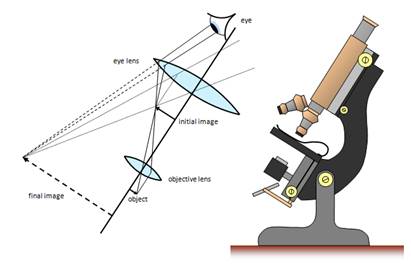Define the magnifying power of a compound microscope when the final image is formed at infinite. Why both the objective and the eyepiece of a compound microscope must has short focal lengths? Explain.
Angular magnification or magnifying power of compound
Microscope is defined as ratio of angle made at eye by image formed
at infinity to the angle made by object, if placed at a distinct of distant
vision from an unaided eye.
When the final image is formed at infinity, the angular magnification due to the eye piece is given by:
Magnification due to eyepiece, Me=D/fe
Where D is the near point of eh human eye,
Fe is the focal length of the eyepiece lens,
The angular magnification for the objective lens is given by
Magnification due to objective lens, Mo=L/fo
Where L is the length of the tube,
Fo is the focal length of the objective lens,
Thus, the total magnification, when the image is formed at infinity, is
![]()

Magnification, 
Where, L = length of the microscope
D = diameter of the lens
f0 = focal length of the object
fe = focal length of the eyepiece
The objective and eyepiece lens should be of small focal length
As ![]() .
.
Thus lower the focal length higher will be its magnifying power.